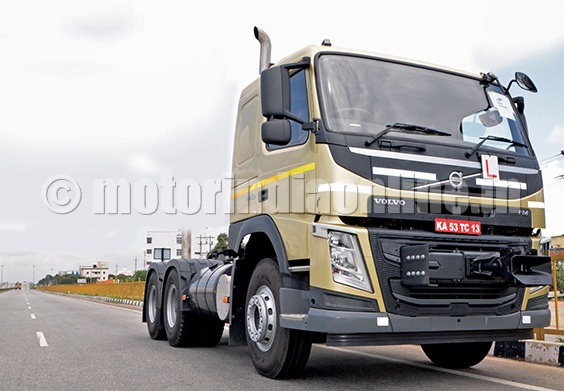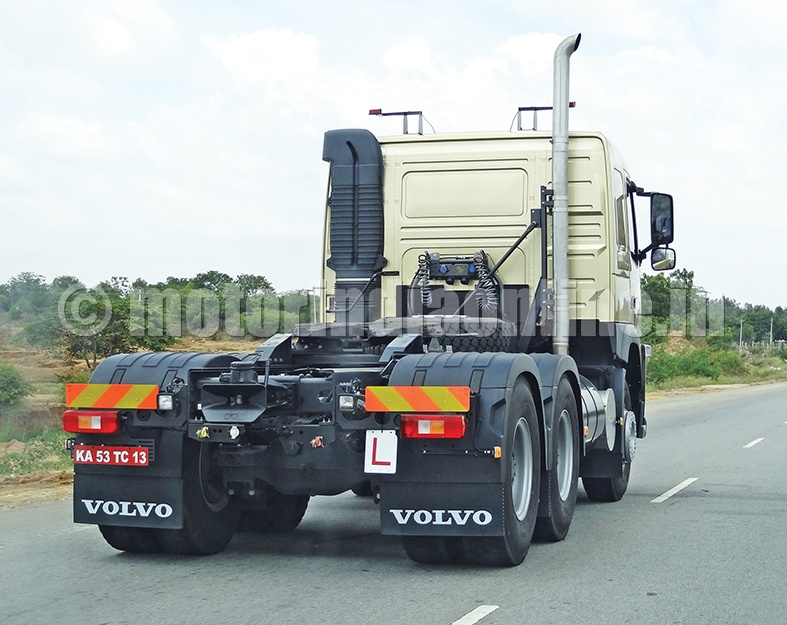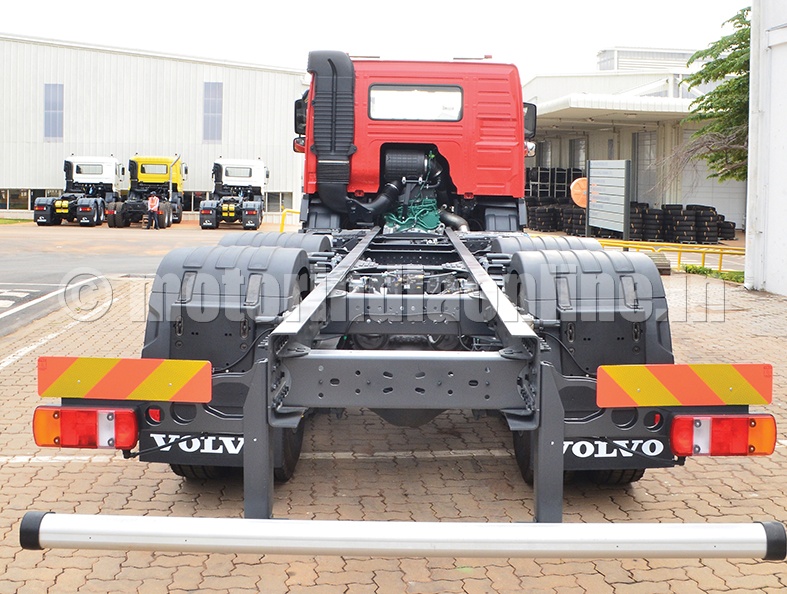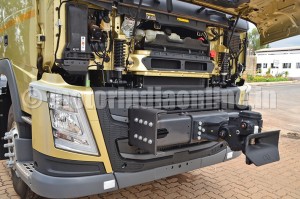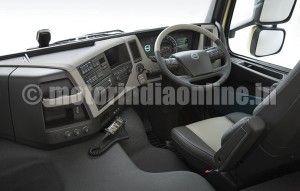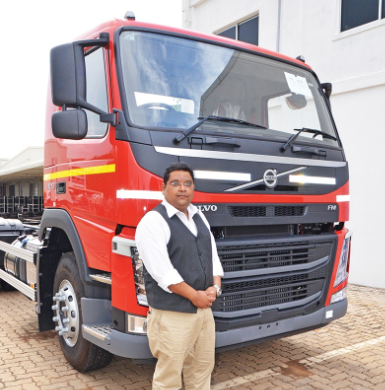“Do not go where the path may lead, go instead where there is no path and leave a trail”, the inspirational quote of Ralph Waldo Emerson, the well-known American poet of the 19th century is probably the approach taken by the truck behemoth Volvo to stamp its class and excel in the global transport domain. Even a cursory glance at some of the recent innovations like the I-shift, dynamic steering, dual-clutch transmission, collision warning with emergency braking system and stretch brake will reflect the passion and focussed approach of the company in exploring new vistas to set the trend and take the lead in its operational realm. In the Indian context, since its entry in 1998, Volvo has introduced varied heavy duty truck models for the construction, mining and haulage applications that have become trend setters in the segments. Many of these were launched where no market existed per se but Volvo’s committed approach, service backup and the state-of-the-art truck provided a compelling value proposition to the buyer; the market responded with gusto and the rest is history. In the niche higher HP truck class the company has the major market share and now it’s all set to further strengthen that position thro’ its latest product offering ‘The new Volvo FM’.
The new Volvo FM global truck was launched for the European market at the Birmingham CV show during April 2103 and around 6 months down the timeline, launched for the Asia market. It was introduced subsequently for the Indian market during Oct. 2014 and after the homologation process, commercially launched during Jun 2015, indicated Mr. Siddharth Kirtane, Head – Marketing, during his interactions with MOTORINDIA team. The meeting with Mr. Siddharth Kirtane and the marketing & technical teams took place at Volvo factory, Hosakote, on 17th Aug. ‘15 and the instant was the media driving impressions of The new Volvo FM organised exclusively for MOTORINDIA. The on-road driving experience program was preceded by Volvo overview presentation and product walk around discussions.
Tractor and Rigid variants
The new Volvo FM is a flexible all-rounder, picks up the best of the features from the FMX and FH platform trucks and suitable for both on and off road applications. The main attribute is flexibility which comes from adaptability to the varied specs and demands of the body builder to match field applications and the all-rounder tag is due to its suitability for all terrain applications. Two models are being launched from the platform, the first being a tractor version for ODC applications and the second a rigid truck for special applications.
The tractor is 440 HP, 2200 Nm, 6X4 version & rated 125 ton GCW for ODC applications. The tractor is a push pull type and the front tow hook provided on the extended chassis. The rigid truck, 25 ton GVW 6X4 version offered has the same power ratings and features as that of the tractor; and additionally the I-shift AMT, BS-3 (440 HP) & BS-4(420 HP) emission norm variants, adaptations to suit body builder demands for superstructure and equipment integration work.
Product walk around
Tractor and rigid versions were exhibited for the observations. Looking at the tractor’s front side, the tow hook caught the attention, it being fixed on the cross member attached to the chassis extension below the cabin. Upon opening the front cover below the windshield, one could see the electrics and pneumatics cluster junctions located on either side. The above ensures that there are no zigzag routing of pneumatic or electric lines and enables easier maintenance. Also the Air Production Modulator (APM) located on the side of the chassis combines all the functions of the pneumatic system like air drier, safety valves and other related controls so that the maintenance becomes easy.
The rigid version displayed was for firefighting application, aptly with a red cabin. The SCR (Selective Catalytic Reduction) unit for achieving BS-4 could be seen attached to the side of chassis. For driving the auxiliary loads like the pumps, engine mounted/flywheel PTO or the transmission PTO are available, with the I-shift version offered considering the application needs. Chassis extensions are provided as per body builder’s requirements, with the Volvo team interacting extensively with the body builder and customer to freeze the specs, in order to bring down manufacturing time for the body builder and also to ensure the desired stability and performance specs are met.
On-road test drive
“Firstly you have to go around the truck and check for the oil/ coolant level, tyre pressure, tread wear, headlamp & indicators, battery condition etc, before entering the cabin,” pointed out Mr. Hari Babu, Manager – Customer Training, Competence Development Centre. Noting the instructions and demos, we got inside along with him to take in turn the steering wheel for the drive experience.
Mr. Hari Babu explained the basic operations and features of the tractor; and various other switches and controls impressively organised. The ergonomics of design was discernible in the spacious cabin and its low positioning on chassis with large windscreen indeed gave a good visibility. The air-suspended seat and the steering column were adjustable to suit the driver comfort level. In the absence of the steering lock and ignition switch, steering column was sleeker and more legroom available for the driver. The electric parking brake included the above functions and actuation of the same was by a switch, definitely an appealing and useful feature. Without wasting much time the drive started and after a few rounds on the factory test track to get the feel for the truck, we hit the old Madras road to Kolar.
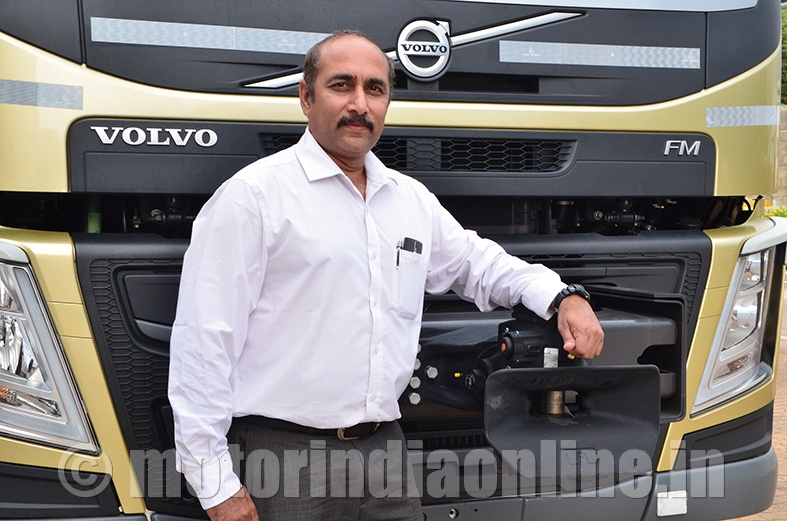
It took some time to come to grips with the functional features of the truck and with Mr. Hari’s guidance, we effected the gear changes with minimal effort; utilised the small shift lever provided in the gear stick to move into the upper gears and rolled along smoothly at higher speeds. During the 80 km drive towards Kolar and back, the various features of the vehicle were time and again tested. On the long stretch switching on the cruise control allowed us to take the foot off from the accelerator, a convenient feature alright. Applying exhaust brake gave more control during downward slopes – the 3 positions of the exhaust brake control lever were checked for their varying degrees of braking and it was impressive at higher engine rpm. The dual gear selector effected thro’ a switch enhanced the cruise speed choice and definitely was an advantage in the applications. The overall truck handling was easy, smooth and controls located at convenient places added on to driver’s comforts.
We returned back to the test track to take on the rigid version. The rigid version had the I-shift AMT and the controls were a lot simpler. Just easing the truck into the drive mode and stepping on the gas pedal smoothly moved the truck on its course. Driving the truck has never been so simpler especially for the less skilled/experienced persons. It was indeed an exhilarating experience to be at the steering wheel and it should come as no surprise if the driver productivity shoots up in The new Volvo FM.
After getting down from the truck, we looked at the parked vehicles with admiration and a healthy respect – the technical features explained vis-a-vis performance enhancement, driver comfort, etc., meant so much more after the drive experience. The new Volvo FM being positioned for the market has indeed raised the bar higher and the flexible all-rounder bound to become a star player in the team – that day may not be too far in the timeline.
Interview with Mr. Siddharth Kirtane, Head – Marketing, Volvo Trucks
Excerpts:
Can you highlight the significance behind ‘The new Volvo’ name for the models and if Indian customers are maturing fast to receive the global products?
Volvo’s philosophy in model nomenclature has been quite consistent over the decades with FM, FMX, FH & FL families indicating the specific features in the platforms, viz., F indicating the forward control, M, H & L indicating the cab heights as high, medium, low and X indicating the off-road applications. In India we have FM and FH positioned for regional and long haul applications. To distinguish the new introduction from the old classic version, the flexible all-rounder model launched has been named The new Volvo FM.
Regarding global product being accepted in India, I can talk about Volvo’s experience and it’s happening in less than a year. The time lag primarily has been due to emission norms – moving from Euro 6 to 3 in stages as we introduce the products in the varied markets. Our ambition is to have a global launch for all the markets together.
Tell us about the market segments for which the models are being positioned and the USPs.
Tractor is being positioned for ODC and with its increased HP and torque, it can carry more load and provide better performance. In Europe the truck is positioned for speed while it’s for higher loads in India. Apart from the axle ratio of 5.41 offered, we can provide also 3.7 & 4.2 as per requirements. Dynafleet online transport information system to give the positon and performance data of the vehicle is another feature that should appeal to the customer. As for the rigid version, Volvo is targeting special applications like the fire tender, boom pump, crane truck, oil rig etc., where higher HP, reliability, productivity, higher speeds/ acceleration on wheels and faster equipment operations cycle are very important.
Indicate the I-shift features and its acceptance in the marketplace. When do you propose to introduce here the other global features like dynamic steering and dual-clutch transmission?
I-shift will be a standard feature in rigid truck and not offered in the tractor version due to nature of applications; tractor speeds are low and invariably these operate in the range 1st to 4th gear and I-shift utility is not there. We have received favourable field feedback from FMX customers using I-shift and are sure that the feature will appeal for special applications and appreciated by end users. Dynamic steering is a fantastic innovation and should be introduced for Indian applications over a period of time. The dual-clutch is essentially for long haul in FH platform primarily for the European market and may not be introduced here.
Please comment about the service support for the model.
We have an excellent established network of service workshops mostly run by Volvo with many of our own service personnel deployed therein. These workshops are located near the mines where the FMX trucks are already in operation, like in Singrauli, Chandrapur, Korba and Singareni. Once the power plants come up, The new Volvo FM tractor would be transporting ODC for power plants and the workshops in those places can attend to service of the tractors. We have thus a significant advantage over the competition vis-à-vis service aspects and the user segment is aware about this too.
What are your views regarding the growth drivers, market size and envisaged Volvo’s share for the new models?
Growth driver has to be in the pick-up of the power sector in a big way. The new UMPPs and other MPPs invariably demand ODC transport of bigger/heavier boilers, turbines, transformers and miscellaneous power gear equipment and hence the demand for FM should go up. In a good year we have done around 250 nos. for ODC and this could go up significantly if the power story falls in the slot. We have the major market share and about 80% of the customers looking for trucks in over 400 HP range are opting for Volvo; and that has helped us. The rigid models are being targeted for special applications and we aim to do about 25 nos. to start with in a good year.
By S. Anantharaman & N. Balasubramanian
